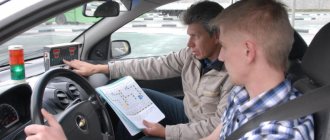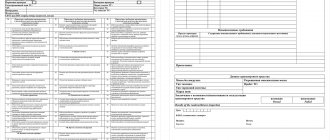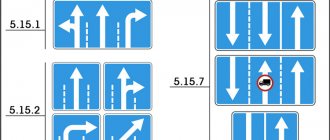Recently, many innovations related to road safety have appeared in the legislation of the Russian Federation. All of them are taken with a purpose. Any violation of traffic rules was always followed by one punishment or another. But not all drivers know that for cases of repeated disregard of the rules, tougher penalties are now provided. Basically we are talking about violations that can lead to serious accidents and for this reason are punishable by large fines or confiscation of the driver's license for a long time. The question arises: what does “repeated traffic violation” mean, and under what circumstances is it recognized? The exact definition of this concept is contained in the Administrative Code.
When do violations fall into the “repeated” category?
A single violation most often entails a standard fine. But after non-compliance with the rules is recorded by a traffic police officer and an appropriate decision is made, the likelihood of a repeat violation arises.
According to Article 4.6 of the Code of Administrative Offences, a citizen who has committed a violation and paid a fine is considered to be punished within the next 12 months. And if during this time a similar violation occurs again (namely, within the framework of one article of the code), it is recognized as repeated. Thus, the period for repeated traffic violations is 1 year.
The exact scope of this period is associated with most ambiguities. It is important to remember that it does not count from the moment of the violation. Only the sentencing decision will be marked with this date. Then the offender is given a certain period of time - 10 days. If the appeal does not occur, the administrative penalty comes into force, but this is not the beginning of the period. And it starts from the day the fine was paid. If, as a punishment for the first violation, the driver’s license was taken away, then the period for repeated traffic violations begins to apply only after the period of deprivation has expired.
Having stopped a violator, traffic police officers can always query the database and find out whether he has unpaid fines and whether similar cases have been recorded against him. And if similar precedents have already taken place over the past 12 months, the inspector notes this and transfers the report to the police department or to the court, where the punishment will be established. It is worth noting that even if the traffic police officer did not immediately request data on similar violations, this will certainly be done after sending the report to the police.
What is the penalty for repeat violation?
Not all offenses are punishable by tougher measures. But in some cases, special punishment is provided for repeated traffic violations:
- lack of vehicle registration certificate;
- speeding by 40 km/h or more;
- driving on "red";
- driving onto oncoming traffic or tram tracks;
- violation of the rules for crossing a railway crossing.
For all these violations (except for the second paragraph), the Administrative Code imposes sanctions in the form of deprivation of a driver’s license for up to 12 months or a fine of up to 5,000 rubles. But what kind of punishment will follow depends on the exact circumstances.
The most severe penalties are applied to persons repeatedly caught driving while intoxicated. Even before the amendments were adopted, driving in this state threatened the driver with deprivation of his license for a long period and a large fine. But since 2015, an amendment has been made to the law regarding such cases. Now they can entail not only administrative liability. A criminal case may be opened against the driver, as a result he will receive a fine of up to 300,000 rubles or be imprisoned for up to 2 years.
Drivers should remember that violations recorded by photography and video are not subject to deprivation of rights. In these cases, only the collection of an administrative fine is possible.
In the situation with the confiscation of a driver’s license, there is another important point. To get your license back, you must successfully pass a theoretical test on traffic rules, having paid the state fee in advance. It must always be taken, regardless of the period of deprivation.
What kind of punishment will follow for a repeated violation depends on the characteristics of the driver and all the circumstances of the situation. The final decision is always made by the court, not by traffic police inspectors. It happens that police officers do not take into account the fact that the period for repeated violation has already expired, and issue increased fines. In this case, the driver always has the right to appeal to the judicial authorities and appeal the inspector’s decision.
The other day I had a dispute with a traffic police inspector who wanted to fine me for allegedly committing an administrative offense again. The fact is that in May last year I was fined for speeding. Until the end of the specified month, I paid the fine through State Services and continued to drive the car calmly.
More than a year has passed since I was stopped again for exceeding the amount, and now the inspector stated that since the money arrived in the account only in June, I am being issued a fine in an increased amount, since I am a repeat offender and not a year has passed since I was recognized as a violator.
When they began to look into the issue, I was able to prove with the help of an extract from the State Services portal that the transfer was sent before the end of May, and why the payment was delayed by the system or the bank no longer concerns me. As a result, I got off with a standard fine, which I paid immediately. To avoid such a situation, I would like to give readers a number of tips regarding repeated traffic violations and the penalties imposed.
The last few years have seen a serious tightening of sanctions applied to traffic violators. The drafters of the rules paid special attention to persons who committed an offense repeatedly. According to legislators, such solutions can reduce the percentage of accidents and thereby make traffic on highways and roads safer for all participants. Radical amendments affected the amount of penalties and the procedure for determining other penalties.
The definition of the concept is given in Art. 4.6. The Code of Administrative Offenses of the Russian Federation, which clearly states that if a citizen who has violated traffic rules repeats his offense within the next 12 months, he will be considered a repeat offender and more severe penalties can be applied to him. When determining who may be a violator who has committed an administrative act repeatedly, you should carefully consider the existing regulations.
How long will a traffic violation be considered a repeat violation in 2020?
A year must pass from the date of imposition of punishment for a previous offense before the driver can repeat it without too unpleasant consequences for himself.
Repeated driving while intoxicated is especially punishable. The moment from which the period is calculated:
- If a fine was imposed as punishment for a previously committed offense, then the one-year period is calculated from the moment of its payment. In this case, it does not matter whether the fine was paid ahead of schedule or whether a 50% discount was assigned on it.
- If your driver's license was taken away, the period of deprivation ends.
If the crime is committed repeatedly, the statute of limitations for deprivation of rights begins to expire from the moment they were returned to the owner, in accordance with the provisions of the Code of Administrative Offences.
Amendments have been made to the Criminal Code, according to which a driver who was previously caught and punished for drunk driving and commits this offense again will be punished not under the administrative, but under the criminal code.
The size of the fine in this case increases significantly - it amounts to 300,000 rubles. This standard applies not only when driving a personal car, but also when driving public transport - trams, trolleybuses.
How does the inspector determine that non-compliance has already been committed?
When drawing up a protocol, the traffic police inspector checks the driver against a newly created database in order to make sure that no fines have been previously imposed for drunk driving or other serious offenses.
If a repetition of the offense is detected, the documents are transferred to the traffic police department, where a final decision will be made. Most often, the case is sent to court for further consideration.
What is the fine for xenon, see the article: xenon in the PTF according to the law. Read about the rules of the MTPL Law according to the current edition in 2021 here.
The Code of Administrative Offenses has specialized articles that set out the prescribed punishment for repeated commission of the same offense by a citizen.
What punishment awaits the second time driver?
One of the most serious traffic offenses is drunk driving. If the driver is caught while driving normally, he can still get off with a fine, the size of which is quite large - about 50,000 rubles or 300 thousand rubles according to the Criminal Code of the Russian Federation.
Deprivation of rights for a long period is carried out if the fact of the driver’s intoxication is discovered during a serious accident in which there will also be victims. In this situation, criminal liability is established.
For speeding
The fact of speeding is recorded by special photo and video devices:
- radar;
- stationary radar;
- video cameras installed in different parts of the city.
According to the Administrative Code, if the speeding is insignificant, a second fine is imposed in the usual amount - up to 5 thousand rubles.
The situation is different if the driver exceeded the speed limit by more than 60 km. hour. In this case, the prescribed punishment is deprivation of a driver’s license for up to 1 year.
Drivers are often interested in how much speeding is permissible. The correct answer in this case is none. However, the penalty for exceeding up to 80 km. per hour is most often not assigned.
Drunk driving
The most severe penalties apply for repeat drunk driving. In this case, it is necessary in order to prevent a serious accident. The applicable punishment is deprivation of rights for up to 3 years.
Also, by court decision, another type of punishment may be chosen:
| Fine | In the amount of up to 300 rubles, and from the average income of the guilty person, calculated for 1 or 2 years |
| Mandatory work | Within 480 hours |
| Serving a sentence | In a general regime colony |
So, if the driver does not correct himself and violates the law again within one year, a more severe punishment is applied - an increased fine or deprivation of his license.
Tinting
The most common violation is improper window tinting. Believing that they will get a ride, drivers pay a small fine and continue driving with film on their windows.
However, if you stop again, the amount of the penalty increases significantly. Initially, the fine is 500 rubles, but if the driver is caught again, the penalty increases to 1,500 rubles. This is provided for in Article 12.5 of the Code of Administrative Offences.
Video: Fines for traffic violations
What aggravating circumstances may influence the choice of sanction?
The very fact of committing an offense is repeatedly considered as an aggravating factor. The fact is that since a citizen has already been punished for such an act, this should have the necessary impact on him. If this does not happen, then the judge and inspector should no longer be loyal to the driver. In practice, court decisions are almost always made not in favor of the offender.
However, the acts can be different and, taking into account the existing aggravating factors, the punishment can be very serious. We are talking about such moments as the desire to pass a red light in time or driving while intoxicated. In this case, the aggravating factor will be the increase in the degree of danger to others as a result of the actions committed.
Recording all road accidents and administrative fines in a single database will make it possible to identify repeated violations. To obtain the necessary information, the inspector only needs to make a request to the database and obtain the necessary information.
What types of fines and other penalties are provided for repeated traffic violations?
The measures taken against the culprit today are very strict. This was done specifically to make drivers more responsible and attentive. The system of penalties is very impressive:
- In case of repeated driving through a red signal and a prohibiting gesture on the part of the inspector, a fine of 5 thousand rubles or deprivation of driving license for a period of 4 to 6 months is provided.
- When driving an unregistered vehicle, the fine will be 5 thousand rubles or deprivation of rights for 1-3 months.
- Repeated driving while intoxicated is punishable by three years' imprisonment or 480 hours of community service. Additionally, a significant fine will be imposed.
- For transferring a vehicle to a drunk driver, he faces the same disciplinary action as in the previous paragraph.
- Exceeding the speed limit by 60-80 km/h is punishable by deprivation of rights for a year and a fine of 5 thousand rubles.
- When driving on the railway again, a fine of 5 thousand rubles is issued.
In any case, the final decision on the case is made by the judge who considers the appeal of the traffic police officer, but taking into account the recorded circumstances.
All repeat fines
So, now let's list all the sanctions available for 2021 for repeated violations of the Administrative Code. There are quite a lot of them, so we present them in a convenient tabular form.
| For what? | Article of the Administrative Code | Punishment for repetition |
| Repeated driving of a car that is not registered with the traffic police MREO | 12.1, part 1.1 | 5000 rubles or imprisonment for 1-3 months |
| Driving while intoxicated when the driver is already imprisoned | 12.8, part 3 | Arrest for 10-15 days or 30,000 rubles for persons to whom arrest cannot be applied |
| Driving while intoxicated, when the driver is already imprisoned for drunkenness or refusal of a medical certificate | Article 264.1 of the Criminal Code | A monetary penalty of 200 to 300 thousand rubles or in the amount of the average salary of the convicted person for 1-2 years, compulsory community service for up to 480 hours, forced labor for up to 2 years, or imprisonment for up to 2 years. |
| Repeated speeding by 40-60 km/h | 12.9, part 6 | 2000-2500 rubles |
| Repeated speeding by more than 60 km/h | 12.9, part 7 | Deprivation of rights for 1 year or 5,000 rubles in case of auto registration |
| Repeated stop on railway tracks, repeated passage through a prohibiting traffic light through railway tracks or a closed barrier | 12.10, part 3 | Withdrawal of rights for 1 year |
| Repeatedly driving through a red traffic light | 12.11, part 3 | 5000 rubles or imprisonment for 4-6 months |
| Repeated prohibited entry into oncoming traffic | 12.15, part 5 | Withdrawal of rights for 1 year or 5000 in case of auto-fixation |
| Repeated driving against the direction of a one-way track | 12.16, part 3.1 | Imprisonment for 1 year or 5000 in case of auto-fixation |
From what time does the period of repetition for a similar traffic offense begin to run?
According to Article 4.6 of the Code of Administrative Offenses of the Russian Federation, the statute of limitations for repeated offenses begins to run from the moment the period of deprivation of rights ends. This means, in our example, if a driver is repeatedly caught driving a car while intoxicated within a year after the end of the deprivation of rights, he will be subject to liability, according to the Code of Administrative Offenses of the Russian Federation for a repeated offense - 3 years deprivation of the right to drive a car + 50,000 rubles.
Let us remind you that on July 1, 2015, amendments to the Criminal Code of the Russian Federation also came into effect, according to which for repeated driving of a car (within 12 months from the end of the period of deprivation of rights for driving while intoxicated), according to which the court can impose a fine of 200 thousand to 300 thousand rubles.
«Article 264.1. Criminal Code of the Russian Federation:
Violation of traffic rules by a person subject to administrative punishment
Driving a car, tram or other mechanical vehicle by a person in a state of intoxication, subjected to administrative punishment for driving a vehicle while intoxicated or for failure to comply with the legal requirement of an authorized official to undergo a medical examination for intoxication, or having a criminal record for committing a crime provided for in parts the second, fourth or sixth article 264 of this Code or this article, -
is punishable by a fine in the amount of two hundred thousand to three hundred thousand rubles
or in the amount of wages or other income of the convicted person for a period of one to two years with deprivation of the right to hold certain positions or engage in certain activities for a period of up to three years, or compulsory work for a period of up to four hundred eighty hours with deprivation of the right to occupy certain positions or engage in certain activities for a term of up to three years, or forced labor for a term of up to two years with deprivation of the right to hold certain positions or engage in certain activities for a term of up to three years, or
imprisonment for a term of up to two years
with deprivation of the right to hold certain positions or engage in certain activities for a period of up to three years."
Let's give another example:
The driver was stopped by traffic police for driving through a red traffic light, for which he was subject to administrative liability in the form of a fine of 1,000 rubles. (Article 12.12 part 1 of the Code of Administrative Offenses of the Russian Federation). From the moment the driver pays a fine in accordance with Article 4.6 of the Code of Administrative Offenses of the Russian Federation, the statute of limitations for an administrative offense begins to apply, which is 1 year or 12 calendar months.
If, within a year after paying the fine, the driver is again prosecuted under Article 12.12 Part 1 “Jumping through a prohibiting traffic light signal or a traffic controller’s prohibiting gesture...”, then, according to the new legislation, the driver is subject to prosecution under Part 3 of Article 12.12 of the Code of Administrative Offenses of the Russian Federation, which provides for a fine in the amount of 5,000 rubles or deprivation of the right to drive a motor vehicle for a period of 4 to 6 months.
What measure of liability will be chosen for a driver who repeatedly ran a red light within a year from the last similar one will be decided by the court based on the characteristics of the driver and the circumstances of the administrative case.
“Primich. author: According to judicial practice in administrative cases, as a rule, the judicial authorities, in case of repeated offenses, prefer to deprive drivers of their driver’s license, citing the presence of past traffic violations (despite the terms and their payment).”
How are fines repeated?
So, the list of repeated financial sanctions is quite wide. But not all punishments for recidivism are imposed in the form of fines - there is also deprivation of rights and arrest for this. Therefore, we will present all such articles of the Code of Administrative Offenses that provide for repetition. Let's start with the most common ones.
What is the penalty for repeated deprivation of rights?
This question is asked quite a lot by car enthusiasts, but it is not entirely correct in its content. There is no monetary penalty for repeated deprivation of rights. If deprivation, if you are caught again within a year for the same offense. But this is not provided for in all articles of the Administrative Code.
For example, if you are already a deprived person, and are caught in this status while intoxicated, then you will be subject to arrest for a period of 10 to 15 days (Part 3 of Article 12.8 of the Administrative Code). This article is valid when the previous withdrawal of the right to drive was not for intoxication or for refusing a medical examination.
But for repeated driving while drunk (when your license was previously confiscated also for intoxication), you may already face a criminal fate - Article 264.1 of the Criminal Code of the Russian Federation for repeated driving “under the influence” provides for one of the variations of the sanction (by court decision):
- monetary sanction from 200 to 300 thousand rubles,
- monetary punishment in the amount of the average salary of the convicted person for 1-2 years,
- compulsory work up to 480 hours,
- forced labor for up to 2 years,
- imprisonment for up to 2 years.
What is the penalty for driving again without insurance?
But this violation has no recurrence. No matter how many times you are caught with expired or missing MTPL insurance or not being included in the policy, you will face a sanction of 800 or 500 rubles, respectively, each time.
The bad news here is that for a long time no days have been given to eliminate the violation, and after the first punishment you simply have no right to go further except by tow truck.
You will also be interested in:
- Petition to the traffic police and the court in questions and answers. Sample, terms and rules
- Is it possible to drive a car after revocation of a driver’s license and for how many days?
- How to properly submit a petition for consideration at the place of residence and not be refused?
What is the repeat fine for tinting?
Driving a vehicle with a light transmittance of the front hemisphere glass of less than 70% as measured by a certified and verified device is punishable. The monetary penalty for tinting is 500 rubles under Part 3.1 of Article 12.5 of the Administrative Code.
There is no repeat fine for tinting, as well as for insurance. But the authorities are considering the adoption of a law on the repeatability of driving with tinting. In this case, the monetary penalty will increase several times if you are caught the second and subsequent times within a year. But so far, as of May 22, 2021, this law has not been adopted. You can read more about this in the article about fines for tinting.
List of all repeated traffic violations for which deprivation of rights is provided
Repeated driving through a red traffic light, or a traffic controller prohibiting sign ( Article 12.12 part 3
)
/ Period of imprisonment: 4-6 months
Repeated driving of a vehicle not registered in accordance with the established procedure ( Article 12.1 Part 1 1 of the Code of Administrative Offenses of the Russian Federation
)
/ Period of imprisonment: 1-3 months
/ or a fine of 5,000 rubles (the penalty is applied at the discretion of the court)
Repeated driving of a car by a driver who is intoxicated ( Article 12.8 Part 4 of the Code of Administrative Offenses of the Russian Federation
) /
Term of imprisonment: 3 years
Transfer of control of a car to a person in a state of intoxication ( Article 12.8 Part 4 of the Code of Administrative Offenses of the Russian Federation
) /
Imprisonment period: 3 years
/ and a fine of 50,000 rubles (the penalty is applied at the discretion of the court)
Repeatedly exceeding the established speed of a vehicle by more than 60 kilometers per hour ( Article 12.9 Part 7 of the Code of Administrative Offenses of the Russian Federation
) /
Imprisonment period: 1 year
Repeatedly exceeding the established speed of a motor vehicle by more than 80 km/h ( Article 12.9 part 7 of the Code of Administrative Offenses of the Russian Federation
) /
Imprisonment period: 1 year
/ or a fine of 5,000 rubles in case of recording violations by technical means operating in automatic mode
Repeated crossing of a railway track outside a railway crossing, entering a railway crossing with a closed or closing barrier or with a prohibiting signal from a traffic light or a crossing officer, as well as stopping or parking at a railway crossing ( Article 12.10 part 3 of the Code of Administrative Offenses of the Russian Federation
) /
Period of imprisonment: 1 year
/
Repeated departure (within a year from the last traffic violation) in violation of traffic rules on the side of the road intended for oncoming traffic, departure onto tram tracks in the opposite direction ( Article 12.15 Part 5 of the Code of Administrative Offenses of the Russian Federation
) /
Period of imprisonment: 1 year
/
Repeated violation, which consists of driving in the opposite direction on a one-way road ( Article 12.16 Part 3 1
) /
Imprisonment period: 1 year
/ or a fine of 5,000 rubles (the penalty is applied at the discretion of the court)
Let us remind you that if repeated violations of traffic rules are detected using photo and video recording systems, the measure of liability in the form of deprivation of rights under the above articles does not apply.
In this case, the traffic police authorities responsible for the complex of photo and video recordings issue an administrative resolution to impose a fine provided for in an article of the Administrative Code of the Russian Federation.
What are the restrictions?
The speed of vehicles regulated by law depends on several circumstances:
- location of the road and its type;
- type of transport and its technical characteristics;
- maneuvers performed by the vehicle.
The first violation results in a fine, the amount of which depends on how much the speed was exceeded at the time the violation was recorded. The fine varies from 500 to 5000 rubles. If the speed limit is violated by more than 60 kilometers per hour, the traffic police inspector makes a decision to revoke the driver's license.
Exceeding the speed limit is considered to be more than 20 km/h indicated on the sign. However, speeding up to 20 km/h is punishable by a verbal warning and is not considered an offence. From the point of view of the law, such a violation is not prosecuted.
Non-compliance with the regime can be recorded automatically, that is, with the help of cameras or under direct control by traffic police officers. In this case, they can issue a receipt for payment later.
Fine for driving without compulsory motor liability insurance – is it possible to avoid or challenge it in court?
Speed limits and fines for speeding are established in Article 12.9 of the Code of Administrative Offenses of the Russian Federation.
How do the traffic police find out if the violation is repeated?
All State Traffic Inspectorate bodies are equipped with electronic means of communication, with the help of which any employee can find out information about any driver.
As a rule, if a driver is brought to administrative responsibility, traffic police officers, before drawing up a protocol on an administrative offense, through the duty station of the State Traffic Inspectorate or using other electronic means of communication, find out information about the driver, etc.
If a traffic police officer sees that the driver has repeatedly committed a traffic violation within a year, for which a more severe penalty is provided (deprivation of rights or an increased fine), then the traffic police officer draws up a report on the administrative violation, but does not issue a decision to impose a fine. Next, the documents are submitted to the duty department to resolve the issue of making a decision on the case or sending the documents to the judicial authorities.
If traffic police officers did not resort to requesting information from the centralized traffic police database to clarify the data on the driver who violated the traffic rules, then a protocol on the violation and a resolution imposing a fine are drawn up.
However, after the documents are submitted to the duty station later, the State Traffic Inspectorate authorities, as a rule, make a request for the driver to clarify whether the driver’s violation falls under the concept of repetition, which is established by articles (see the list of articles above) providing for more severe punishment for repeated traffic violations.
In this case, the traffic police send documents to the judicial authorities to make a final decision on the case, of which the driver who violated the law is required to be notified.
Ways and means of detecting speed violations
Experts attribute these “remarkable” statistics to the increase in the number of speed control devices. Cameras on the roads can be installed anywhere, and in any quantities. It seems that the main purpose of automated systems is not prevention and control over the observance of order on the roads, but a means of filling local budgets and the main activity of numerous security guards (operators) of mobile cameras. Motorists, with their love of speed, provided jobs and money for many.
Lawmakers promise to soon adopt new laws that will regulate the installation and use of automatic and automated speed control systems. Maybe after this, the installation of such means will acquire logic and an understandable algorithm, and most importantly, a limited number per 1 km. roads.
Relationships on the roads between controlling and controlled traffic participants have since ancient times developed like in an action-packed novel. Some sit in ambush and try to catch, others, showing superhuman efforts and intuition, try to hide the fact of the violation. But technological progress intervened here too. The thrill of the plot disappeared and what remained was routine. However, the most inventive and inquisitive minds still find opportunities to deceive.
There are two types of violation monitoring systems:
- Automatic cameras. They operate in a fully automatic mode without affecting human operation. Only installation and maintenance is up to the person.
- Automated. These are mobile cameras, the installation and configuration of which is entrusted to a person.
The use of automatic systems, i.e. operating without human intervention, and these are stationary cameras such as Arena, Strelka, Rapier, etc., recording violations, does not raise any particular suspicions about the unreliability of the data obtained from these means.
They are configured to work in a strictly defined place and record violations of traffic rules and road regulations precisely according to the parameters specified in the program. The program is written to install the device according to specific coordinates and road conditions. And the installation location has been agreed upon with the traffic police department and local authorities. It is quite difficult to get caught here for speeding; to do this you need to be extremely inattentive. And even more so, twice. But automated systems and their use raise many questions. The fact is that these are mobile photo recording cameras (Radius, Berkut, Vizir, etc.). Installation and connection to the area is done by specially trained people. The efficiency of the device will largely depend on who, how and what they were taught. Setup and installation are important. With the help of a “competent” installation, you can significantly increase the number of identified violators, significantly increase both your salary and budget revenues. Mobile cameras mostly record speed violations. They are always skillfully hidden, apparently this is part of the training program, and there is no need to put warning signs at the installation site. This is where drivers end up. It happens more than once.
The third way to deal with violators is through mobile traffic police posts. Traffic police officers are allowed to monitor roads in the most tense and dangerous areas using technical means. In our case, this is a hand-held photo recording device or, as they say, a radar. Crews are also allowed to conduct covert control using the terrain, road infrastructure structures, etc. Or, in simple terms, ambushes. Control can also be carried out on a civilian vehicle. Data about the violation and the violator are transmitted to the crew in a car painted according to the traffic police scheme. This crew “accepts” the violator and carries out registration.
It should be noted that patrolling in traffic police cars is becoming a thing of the past, although it still occurs.
What to do if the deadline has passed since the last traffic violation, but the traffic police authorities send the documents to the court?
If you believe that your rights have been violated, due to the fact that the period established by law has passed since the moment of a similar violation, during which the traffic police authorities and the court can charge the driver for repeated offenses, then contact directly the judicial district to which the State Traffic Inspectorate authorities sent your documents.
Remember that according to Article 4.6 of the Code of Administrative Offenses of the Russian Federation, the expiration date for one offense cannot be more than 1 year from the moment the court decision enters into legal force or from the moment the punishment is executed (payment of a fine for violating traffic rules). Therefore, if the traffic police authorities illegally prosecuted you for a repeated violation of traffic rules, then in court you must provide evidence that the period during which, according to you, you could be prosecuted for a repeated violation, has expired.
“Code of the Russian Federation on Administrative Offenses” dated December 30, 2001 N 195-FZ, an offense committed during the validity period of the punishment for the first, previously committed offense is considered repeated. This period is 1 year from the date of completion of the execution of the decision on the imposition of an administrative penalty.
How to count a year
The cherished period of 1 year is counted from the date of completion of the execution of the decision on the imposition of an administrative penalty. That is, the period is counted from the moment:
- payment of a fine (if a fine is imposed as a punishment). Even if the fine is paid ahead of schedule, within 10 days before the decision on imposition of punishment comes into force. By the way, during this period there is a 50% discount on the payment of certain fines for violating traffic rules (Russian Traffic Regulations);
- expiration of the period of revocation of a driver's license.
How to challenge a fine for a repeat violation
The rules for challenging a fine for a repeat violation are the same as for a primary violation. It all depends on who exactly carried it out. If everything went without trial, and the fine was imposed on the basis of a protocol or resolution of the traffic police, you can appeal through the head of the inspection. Evidence will be needed to confirm the illegality of such sanctions.
With a court order, everything is more complicated. The case materials are always sent to the court if we are talking about such a sanction as deprivation of a driver’s license. You can try to defend your interests during court hearings, or challenge the decision on appeal before it comes into force. As in the case of an appeal to the traffic police, the evidence and validity of the complaint are important for the appellate court.
How to check repetition
Thanks to the introduction of unified electronic databases of the State Road Safety Inspectorate (STSI), a traffic police inspector can immediately determine whether a citizen has committed similar offenses during the year when drawing up a protocol on an administrative offense.
In this case, a decision to impose a fine is not issued. Documents are submitted to the duty station to make a decision on imposing a sentence or redirecting the case to court.
The fact of a repeated offense revealed after submitting the protocol to the duty station is reported to the car owner. Accordingly, the imposed administrative punishment also changes.
What else is worth knowing?
- According to the current legislation, a repeated violation is not only a violation of the same type that occurred earlier within one year, but also any other violation for which administrative punishment is provided in accordance with the articles of the Code of Administrative Offenses of the Russian Federation. That is, the fact itself matters: whether the citizen was brought to administrative responsibility during the last year or not. Is he a law-abiding citizen who has stumbled for the first time, or is he systematically violating the law?
- However, in the specialized articles of the Code of Administrative Offenses of the Russian Federation, devoted to punishments for violations of traffic rules, the first and second, more stringent in case of repeated violations, measures of responsibility for a specific violation of traffic rules provided for in this article are specified.
- And only repeated driving of a vehicle (vehicle) while intoxicated falls under a separate article 264.1 of the Criminal Code of the Russian Federation.
Comparative analysis of punishments
If a person has already been punished for an offense and commits it again, it means that he has not learned the lesson about the need to follow traffic rules. Therefore, the second time the punishment is harsher.
As a rule, repeated offenses are punishable by:
a) a larger fine
- 2-2.5 thousand rubles for speeding by 40-60 km/h (Article 12.7, clause 6 of the Code of Administrative Offenses of the Russian Federation);
- 5 thousand rubles, for most items;
- 10 thousand rubles for driving a vehicle weighing more than 12 tons on public roads without special payment to compensate for the harm caused to it (Article 12.21.3, clause 2 of the Code of Administrative Offenses of the Russian Federation).
b) or deprivation of a driver’s license for:
- 1-3 months for driving a car that has not passed technical inspection and/or is not registered in the prescribed manner (Article 12.1, clause 1.1 of the Code of Administrative Offenses of the Russian Federation);
- 4-6 months, for driving through a red light (Article 12.12, paragraph 3 of the Code of Administrative Offenses of the Russian Federation);
- 1 year, for violating the rules for crossing a railway crossing (Article 12.10, clause 3 of the Code of Administrative Offenses of the Russian Federation); for speeding by more than 60 km/h (Article 12.7, clause 7 of the Code of Administrative Offenses of the Russian Federation); Art. 12.15, clause 5 of the Code of Administrative Offenses of the Russian Federation); for driving in the opposite direction on a one-way road (Article 12.16, clause 3.1 of the Code of Administrative Offenses of the Russian Federation).
Innovation as a relief from punishment
If the commission of a repeated administrative offense is recorded by special equipment operating automatically (certified photo-video recording devices), only a fine of 5 thousand rubles is possible as punishment, and not deprivation of a driver’s license for 1 year, in three cases:
- for exceeding the established speed limit by more than 60 km/h (Article 12.7, clause 7);
- for entering the lane or tram tracks of oncoming traffic (Article 12.15, clause 5 of the Code of Administrative Offenses of the Russian Federation);
- for driving in the opposite direction on a one-way road (Article 12.16, clause 3.1 of the Code of Administrative Offenses of the Russian Federation)
A more severe punishment for a repeated administrative offense is quite predictable. It is better to learn the lesson the first time and change your driving style to a less risky one, so as not to be isolated from society as a criminal element threatening its safety. If you systematically violate the traffic rules established by law, it is quite possible to lose the ability to drive your car for three long years.
Drivers subject to administrative penalties must exercise special caution on the road. If they commit a similar offense, they will be held accountable for repeated failure to comply with traffic rules.
In what cases this happens and which articles of the Code of Administrative Offenses of the Russian Federation are regulated, you can find out in this article.
In case of violation of traffic rules, a citizen is subject to administrative liability. To protect road users and ensure compliance with the law, the government has now tightened measures to punish drivers.
Thus, a repeated violation is considered to be a violation that was committed within 12 months after the end of the executive measure applied against a citizen who violated the law, in accordance with Article 4.6 of the Code of Administrative Offenses of the Russian Federation.
The countdown of this period begins after the relevant resolution on bringing a person to justice and the execution of the punishment assigned to him have gained legal force.
In other words, if a citizen has been issued a fine, within 12 months after paying it, he can be brought to justice again if he commits a similar offense.
The counting period is calculated individually, depending on the situation. For example, if the owner of a car has been deprived of his driver’s license, the one-year period begins to count only after the traffic police inspector returns these rights.
What does repeated traffic violation mean?
Viewed by 164
04/12/2021 This article will discuss what it means to repeatedly violate traffic rules, as well as the time frame during which a driver can be brought to stricter liability. As a rule, repeated violation of traffic rules entails a more severe punishment, but it is not imposed for any violation of the rules.
The content of the article:
- Violations for which “repetition” is taken into account.
- How long does it take for a violation to be considered repeated?
- Who will be held accountable for a repeat violation if the first violation was recorded by an automatic camera?
- Examples of repeated violations.
Violations for which “repetition” is taken into account
So, punishment for repeated violation of traffic rules can be applied in the following cases:
| № | Violation | Article for the first violation | Article for repeated violation |
| 1 | Driving an unregistered vehicle | 12.1 part 1 | 12.1 part 11 |
| 2 | Exceeding the speed limit by 40-60 km/h | 12.9 part 3 | 12.9 part 6 |
| 3 | Exceeding the speed limit by 60-80 km/h | 12.9 part 4 | 12.9 p.7 |
| 4 | Speeding by 80 km/h or more | 12.9 p.5 | 12.9 p.7 |
| 5 | Crossing a railway track outside a railway crossing, entering a railway crossing when the barrier is closed or closing or when there is a prohibiting signal from the traffic light or the crossing officer, stopping or parking at a railway crossing | 12.10 p.1 | 12.10 p.3 |
| 6 | Driving through a prohibiting traffic light or a traffic controller's prohibiting gesture | 12.2 part 1 | 12.12 p.3 |
| 7 | Driving into the lane of oncoming traffic or onto tram tracks in the opposite direction (except for avoiding an obstacle) | 12.15 p.4 | 12.15 p.5 |
| 8 | Driving in the opposite direction on a one-way road | 12.16 p.3 | 12.16 h.31 |
| 9 | Driving a vehicle with a permissible maximum weight of more than 12 tons without paying a fee to compensate for damage caused to federal public roads | 12.213 part 1 | 12.213 part 2 |
| 10 | Driving while intoxicated | 12.8, 12.26, 264 of the Criminal Code of the Russian Federation | 2641 of the Criminal Code of the Russian Federation |
Note.
All articles of the Code of Administrative Offenses listed in the third column of the table (for the first violation) provide for punishment only in the form of an administrative fine or deprivation of rights.
Therefore, further in this article only repeated violations after a fine and deprivation of rights will be considered. How long does it take for a violation to be considered repeated?
To understand what a repeated traffic violation means, you should consider one more concept:
Quote
Article 4.6.
The period during which a person is considered subject to administrative punishment
A person who has been given an administrative punishment for committing an administrative offense is considered subject to this punishment.
from the date of entry into force of the decision on the imposition of an administrative penalty until the expiration of one year from the date of completion of execution of this decision.
Thus, a violation is repeated if it is committed between:
- issuing a resolution to impose an administrative penalty;
- completion of 1 year from the date of completion of execution of the resolution.
Once the “repetition” period begins, everything is simple.
A decision on imposing a fine is made by a traffic police officer or a judge, a decision on deprivation of rights is made only by a judge. With the ending, the situation is more complicated, because... you need to find out from what point to count the year:
- In case of payment of a fine
, the period is counted from the date of payment. - In case of deprivation of a license
, the period is counted at the moment when the driver collects the license from the traffic police.
Note 2
.
If the driver, after deprivation, does not surrender his license to the traffic police, then in case of violation it will be considered repeated. The same applies to the end of the deprivation period. It is the moment when the driver receives the license in hand (after passing the exams) that matters. Only from this day 1 year begins to pass. Thus, if a driver is caught committing the same rule violation within a year from the date of “completion” of the administrative penalty, he will receive a more severe punishment. Who will be held accountable for a repeat violation if the first violation was recorded by an automatic camera?
Earlier in this article we considered a situation where the same driver committed the same traffic violation twice. However, in practice more complex cases can be encountered.
Example
For example,
Irina
drives a car that is registered to her husband,
Sergei
. At the same time, it allows speeding to exceed 70 km/h, which is recorded by a camera operating in automatic mode.
In the described situation, it is not the driver, but the owner of the vehicle who is held accountable (part 1 of Article 2.6.1 of the Administrative Code):
Quote
1.
Administrative liability for administrative offenses in the field of traffic and administrative offenses in the field of landscaping, provided for by the laws of the constituent entities of the Russian Federation, committed using vehicles, in the case of recording these administrative offenses by special technical means operating automatically, having photo functions - and filming, video recording, or by means of photography, filming, video recording, the owners (owners) of vehicles are involved.
That is, a violation recorded by an automatic camera is the first for the owner of the car, and not for the person who was actually driving.
Example
Let's return to our example.
The decision for the violation will be issued in the name of the owner of the car - Sergei
.
If in a few months Sergei
If he exceeds the speed limit by 60-80 km/h, then for him this violation will be considered a repeat violation and he will be deprived of his license. In this case, the actual violation will be the first.
As for Irina
, then if she exceeds the speed by 60-80 km/h, then the violation will be considered her first.
This is what happens by default. And many car owners who entrust control to others find themselves in a similar unpleasant situation.
In practice, it is possible to correct this situation, that is, to “rewrite” the fine on the driver
, who was actually driving. However, you need to take care of this in advance. Let us turn to Part 2 of Article 2.6.1 of the Administrative Code:
Quote
2.
The owner (owner) of a vehicle is released from administrative liability if, during the consideration of a complaint against a decision in a case of an administrative offense, made in accordance with Part 3 of Article 28.6 of this Code, the data contained in it is confirmed that at the time registration of an administrative offense, the vehicle was in the possession or use of another person or has currently been removed from its possession as a result of illegal actions of other persons.
So, if a car owner received a fine for violating the rules and understands that he was not driving at the time of the violation, then the following must be done:
1. You need to file a complaint with the traffic police department whose officers imposed the fine.
2. The text of the complaint must indicate that another driver was driving the car at the time of the violation.
3. It makes sense to attach to the text of the complaint documents confirming the right of the other driver to dispose of the vehicle (MTPL policy in which this driver is included, power of attorney, rental agreement, etc.).
4. The driver who was driving must confirm to the traffic police officers that it was he who was driving.
If everything is done correctly, the fine will be transferred from the car owner to the driver.
Example
That is, if
Sergey
and
Irina
had contacted the traffic police in a timely manner, then a fine for the first violation would have been issued against
Irina
.
And for the violation that Sergei
admitted later, he would have been prosecuted as for the first, and not as for the second.
Examples of repeat violations
Example
On April 30, 2021,
Mikhail
drives into the oncoming lane for the first time.
The trial took place on May 15, 2021. A penalty of 5,000 rubles was imposed (part 4 of article 12.15 of the Administrative Code). Mikhail
paid the fine on May 30, 2021.
If Mikhail
If he drives into the oncoming lane again on September 1, 2021, he will no longer get away with a fine. The punishment for him will be deprivation of rights for 1 year (part 5 of article 12.15 of the Code of Administrative Offenses).
If Mikhail
drives into oncoming traffic on May 31, 2021 or later, the punishment will not be repeated, because More than a year has passed.
If Mikhail
enters the oncoming lane on May 7, 2021, the violation will not be considered a repeat violation, because the trial has not yet taken place and no ruling has been made.
Example
On April 30, 2021,
Vladimir
exceeded the speed limit by 41 km/h and received a fine of 1,000 rubles (Part 3 of Article 12.9 of the Administrative Code). The resolution was drawn up by the traffic police officer at the scene of the violation. The fine was paid on the same day.
If Vladimir
commits a violation before April 30, 2021, it will be repeated.
Example
On April 30, 2021,
Gennady
was caught by traffic police officers in a state of intoxication.
May 5, 2021 Gennady
again found himself driving while intoxicated, but since the trial in the first case has not yet taken place, the violation is considered as the first.
The trial in the first case took place on May 20, 2021, and a 14-month deprivation of rights was imposed. Starting from May 20, violations are considered repeated.
The trial in the second case took place on June 1, 2021, and a 16-month disqualification was imposed.
Gennady
I was in no hurry to submit my license to the traffic police and took it only on July 12, 2021. The period of deprivation is calculated from this date.
The period of deprivation ended on January 12, 2023, but Gennady
I couldn't pass the exam the first time. As a result, he received his license only on February 8, 2023. Within a year after this date, violations will be considered repeated.
Those. in this example, the violations are repeated from May 20, 2020 to February 8, 2024.
I am sure that the examples allowed you to understand what repeated traffic violations mean and in what cases it may occur.
Author of the article Maxim Kalashnikov website: pddmaster.ru
More material from the article section.
At what age can you take your license and at what age can you get it?
Replacement of a driver's license at the MFC
Changes in tickets after the traffic rules update on April 4, 2017
Answers, cheat sheets for traffic rules
Overtaking, what do you need to know?
How to attach a license plate
How to determine which violation was repeated?
If the driver violated traffic rules and was stopped by an inspector, the authorized person will check the citizen for similar offenses and unpaid fines.
Only the court or the traffic police department can hold the driver accountable and impose a repeated punishment for the same violation.
The traffic police officer himself cannot do this, but he is obliged to draw up an appropriate protocol and send it for consideration to the authorized authority. After studying the circumstances of the case, a decision is made to re-punish the person.
It is worth noting several important points:
- a similar offense committed by the same person within a year, for which administrative liability is provided, is recognized as repeated;
- repeated driving of a vehicle while intoxicated is subject to criminal liability under Article 264.1 of the Criminal Code of the Russian Federation;
- The type of penalty for repeated violation of the Rules depends on the original offense and the degree of guilt of the person.
What can be repeated punishment for?
Responsibility for repeated violation of traffic rules is provided for only some rules. To understand this topic in more detail, we recommend that you study the table below.
| Type of violation | Number of the article of the code on administrative rights | Possible penalties | |
| amount of penalty | confiscation of driver's license | ||
| Failure to register vehicles with the traffic police department | part 1.1 of article 12.1 | 5 thousand rubles | 1–3 months |
| Exceeding the speed limit up to 60 km/h | part six of article 12.9 | from 2 thousand to 2,500 rubles | |
| Exceeding the speed limit by eighty km/h or more | part seven of the same article | 5 thousand rubles (if the violation is recorded with special photo or video cameras) | for 12 months inclusive |
| Driving through yellow and red traffic lights or a traffic controller making a prohibiting gesture | part three of article 12.12 | 5 thousand rubles | from 4 to 6 months |
| Crossing railway tracks at a prohibiting traffic light or stopping on railway tracks | part three of article 12.10 | up to 12 months inclusive | |
| Driving in the opposite direction on the road or tram tracks | part five of article 12.15 | 5 thousand rubles (if the offense is recorded by special cameras) | for 12 months |
| Driving on a one-way road in the opposite direction | part 3.1 of article 12.16 | 5 thousand rubles (if the violation is determined by special cameras) | for 12 months |
As you may have noticed, for most traffic violations, the law provides for confiscation of the driver’s license. This is required to protect road users.
If a citizen is capable of committing a similar offense twice, prosecution measures are tightened.
If the violation was recorded on a special camera used by government agencies to regulate compliance with traffic rules, the deprivation of rights is replaced by a fine in a certain amount.
If a mistake has occurred in your case, you can appeal the decision to a higher authority, that is, to the head of the traffic police or in court. However, this requires having documentary evidence of your innocence.









